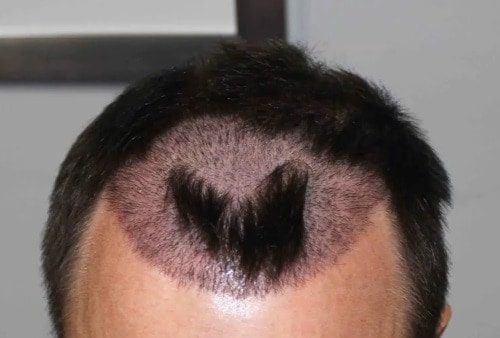Hair Transplant Side Effects

If you’ve experienced balding or hair loss, now is a great time to seek hair restoration services. Modern hair transplant techniques offer positive results to many who choose this effective treatment. However, the procedure is still surgical, which means there’s some degree of risk involved. Although there’s a low chance of adverse side effects, it’s important to educate yourself before proceeding with hair transplant surgery.
The following information covers some of the potential side effects that could occur if you choose to receive a hair transplant.
Scabbing and Itchiness
Whether you undergo the popular Follicular Unit Transplantation (FUT) or Follicular Unit Extraction (FUE) hair restoration procedures, both result in tiny scabs where the implants were inserted. These scabs usually slough off within three days. However, the scabbing may cause itchiness throughout the transplant area. Avoid scratching, as it can remove scabs and delay the healing process. Washing your hair daily with non-perfumed shampoo can help alleviate this side effect. If after the seventh day an area feels itchy, rather than scratching with your nail wrap a tissue around your finger and gently rub the area. The tissue will prevent bacteria laden oil from your finger being rubbed into the healing scalp skin.
Hair Thinning
Hair thinning in the donor area where the transplanted grafts were taken is a common side effect after a hair transplant procedure. This issue causes many patients to become concerned, as it seems they are losing hair from the one area of the scalp they thought was safe. This is due to the vascular disruption and general trauma associated with harvesting the grafts. The effect is greater with Follicular Unit Extraction (FUE) than with Follicular Unit Transplant (also known as Strip or FUT) because much more donor skin is cut. Also, donor thinning with FUE is usually permanent whereas after the FUT procedure, if it occurs at all, almost always reverses itself completely.
Cysts
Cysts can potentially appear in the transplant area after your procedure. They vary in size and may be due to a number of causes including: an in-grown hair, irritation due to the presence of the newly placed grafts, or just secondary to the trauma of the procedure itself. In the end, these cysts are generally benign and resolve after two or three weeks on their own.
Edema
Fluid buildup is another common side effect that can cause swelling on the scalp and face after a hair transplant operation. A small part of the swelling is due to the normal reaction of the scalp- very similar to how any other part of the body swells after trauma. However, most of the actual swelling comes from the fluid that was injected into the scalp prior to and during the procedure. This fluid consists of local anesthetic and saline solution that was used to numb and physically stabilize the scalp (to make it temporarily ridged). As much as half a cup to a full cup of fluid may be injected into the scalp for a hair transplant procedure. After the procedure, gravity slowly pulls the fluid down toward the forehead, ears, eyes, and face. It usually takes about 3-5 days for the fluid to get onto the face. The effect can make a post operative patient look like he went a few rounds with Mike Tyson and lost big time, but it always resolves itself just a few days after that. The doctor will provide a few hints and tricks as to how to minimize swelling on the face.
Sterile Folliculitis and Lichen Planopilaris
Some hair transplant recipients experience a condition called Sterile Folliculitis, which is characterized by a rash or scarring in the transplanted area. It can feel uncomfortable and cause itching. Sterile Folliculitis can also alter the cosmetic appearance of the transplant area. According to the same 2014 study mentioned above, only 23.29 percent of patients experience this side effect. However, Dr. Feller and Dr. Bloxham believe this study may be flawed in that it doesn’t take into account certain variables-including how much excess tissue was left around the transplants at the time of dissection and implantation. The incidence of sterile folliculitis in their practice is near zero- they believe this to be because they perform an ultra refined dissection prior to re-implantation.
Lichen Planopilaris (LLP) is basically a more extreme version of Sterile Folliculitis. This rare inflammatory hair disorder causes excessive scar tissue to form in the transplanted area and can lead to alopecia, causing additional hair thinning. A 2012 study published in the British Journal of Dermatology concluded that LLP is an extremely uncommon side effect after a transplant procedure. So much so that neither Dr. Feller nor Dr. Bloxham have seen a single case in 24 years of their hair transplant practice.
Numbness
About 10 percent of patients experience some form of numbness after their hair transplant surgery. The same study from 2014 published in the International Journal of Trichology found that this side effect usually fades after a few weeks as the body adjusts to the transplant. The reason for the numbness or decreased sensation in the first place is due to the trauma of surgery. The scalp consists of a network of nerves, many superficial branches of which will get cut during the procedure producing numbness. Thankfully, the scalp was designed to endure trauma and re-innervates the numb areas very quickly on its own.
Additional Side Effects to Be Aware Of
A few more side effects can occur following a hair transplant procedure, though they’re extremely rare:
- Hemorrhaging- Minor areas of bleeding that is usually self limiting and not life-threatening.
- Hiccups-
- Donor thinning- After Follicular Unit Extraction (FUE)
- Raised scars
- Infection-rarely more than pimples
- Inflammation of the hair follicles
- Tightness around the scalp
Learn More at Your Hair Restoration Consultation
If you’re concerned about any of the above mentioned side effects, remember that they’re the exception and not the rule. Most hair transplant procedures happen without any problems, leaving patients to enjoy their newly restored hair once it grows in.
The best way to alleviate your concerns is to schedule a consultation with one of our expert hair restoration surgeons at Feller and Bloxham Hair Transplantation. They’ll answer all your questions to make sure your concerns are alleviated before moving forward with any hair restoration procedure. Reach out online or call us at (516) 487-3797 to make an appointment.





